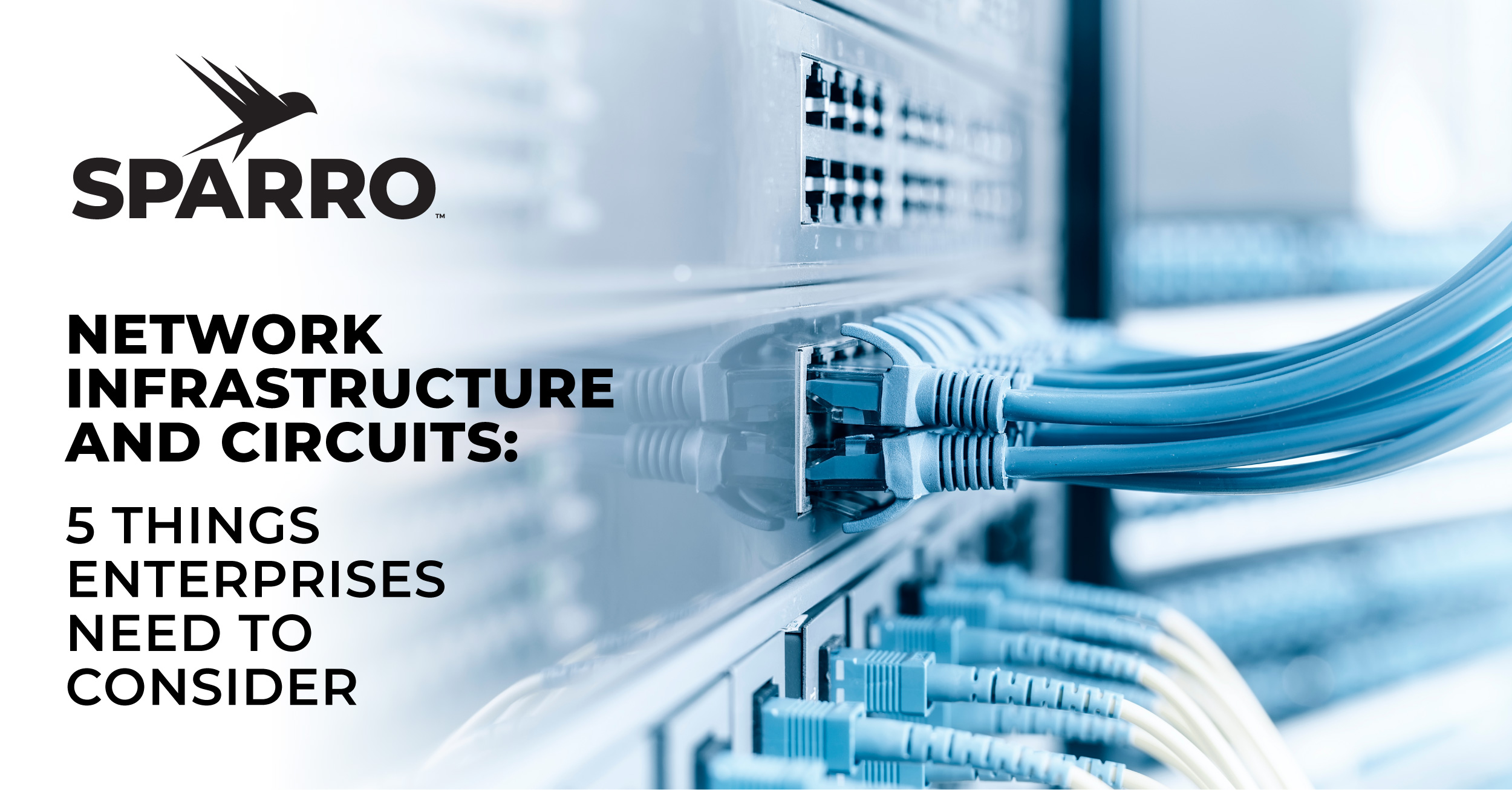Table of Contents
- 1. On-Site Network Infrastructure
- 2. Network Circuits
- 3. Redundancy and Failover
- 4. Security
- 5. Performance and Scalability
Most modern enterprises require connectivity to operate. From manufacturing to agriculture, healthcare to logistics, the always-on, digital-first nature of business requires a robust network infrastructure. It also requires network circuits to connect operations to the outside world. But what do enterprises need to consider? Here, we cover some of the basics.
1. On-Site Network Infrastructure
For on-site communications, there are several widely used options to consider for your network infrastructure, both wireless and wired:
- Enterprise WiFi is already available in many locations, making it a popular choice. WiFi networks are relatively easy to set up and manage but can get congested quickly, making them less suitable for critical communications.
- Cellular networks are widely available and perform well in terms of latency and coverage, but public networks can get expensive and congested. An alternative is a private cellular network with its own security policies and traffic control. This solution offers improved reliability and capacity over a larger area than WiFi networks. Typically, enterprises will reserve private networks for regular traffic that requires low latency and high throughput.
- Fiber offers many benefits over other options, including high bandwidth, fast speeds, low latency, and less “lossiness” over distance. It offers secure data transmission and is less subject to interference than other options.
- Copper cabling such as CAT6/6A Ethernet is another option. It is less expensive than fiber in terms of material costs but needs more frequent replacement. It also has a lower capacity than fiber but is faster than other cabling or wireless options.
Depending on the type of traffic required for your business, there are also other options. For example, an increasing number of enterprises are using Internet of Things sensor networks. While these devices can often use WiFi or cellular communications, other options for sensor networks include Bluetooth, Low-Power Wide Area Networks (LPWAN), NB-IoT (Narrowband IoT), or ISA100 Wireless.
2. Network Circuits
For communication with the outside world, several options are generally used in modern enterprises:
- Primary Enterprise-Level Fiber leverages optical fiber cables for communications, offering advantages such as increased bandwidth, faster speeds, and greater reliability than traditional copper cabling. Fiber optics also provide improved security and sustainability, making them an ideal choice for enterprise infrastructure.
- 5G cellular is another option that uses readily available public wireless infrastructure for communication.
- Cable is also still widely used for external communications. However, it has less capacity and speed than other options and requires more frequent replacement than fiber.
- Less often used is Low Earth Orbit (LEO) satellite communication. This is typically employed where reliable connections are hard to achieve, such as in remote areas.

3. Redundancy and Failover
Establishing network redundancy and a failover plan is crucial to safeguard against catastrophic failures, such as accidental fiber line cuts during construction work. This ensures that your business maintains connectivity in the face of unexpected disruptions, providing peace of mind for continuous operations.
We typically recommend using fiber for a primary connection. A 5G cellular backup will support uninterrupted communications in case of a primary network failure (e.g., due to power loss or physical damage to the circuit). A 5G backup connection will enable critical business functions to continue operating during a loss of the primary circuit.
4. Security
The increasing number of data breaches in many kinds of businesses makes it clear that security is a crucial consideration. Enterprises must implement robust security from network design to operation and maintenance.
Security measures should include firewalls, threat detection, and encryption. Regular security audits and adaptive threat intelligence can also help protect sensitive data and block unauthorized access. It’s also crucial to keep your security measures updated so they can detect and block the latest threats.
5. Performance and Scalability
To stay competitive, your business needs to have a high-performing network. This should address the following aspects:
- Bandwidth – It’s essential to assess how much bandwidth is needed for the expected volume of data used in your business. It’s also crucial to consider the kinds of applications your business uses and what bandwidth they require. For example, videoconferencing or “big data” cloud computing will require more bandwidth than basic email.
- Latency – Similarly, you’ll need to address whether timing is critical for your business’s communications. For example, if your business relies on real-time sensor data and automated responses, you’ll want to ensure your network can achieve low latency in data transmission.
- Reliability – The network must perform consistently to meet business needs. You’ll want to implement Quality of Service (QoS) policies to establish performance standards. Meeting QoS standards will ensure your critical connected business applications perform as expected.
- Scalability – The network should be able to grow along with your business. This means implementing solutions that not only meet your current needs but also anticipate future needs and technological advancements.
Another important aspect involves Service Level Agreements (SLAs). These are agreements with service providers that establish expectations for performance, uptime, and support.
Achieving your required standards for performance and scalability isn’t a one-and-done task. You’ll need to monitor your network continuously and assess it regularly to determine whether it’s still meeting your needs. Thus, ongoing network monitoring and management tools are crucial.
Are you looking to improve connectivity for your enterprise? Sparro can design a robust network infrastructure to meet your budget and business needs. We help you navigate the potential pitfalls and avoid costly mistakes for better results that help achieve your organization’s goals.

